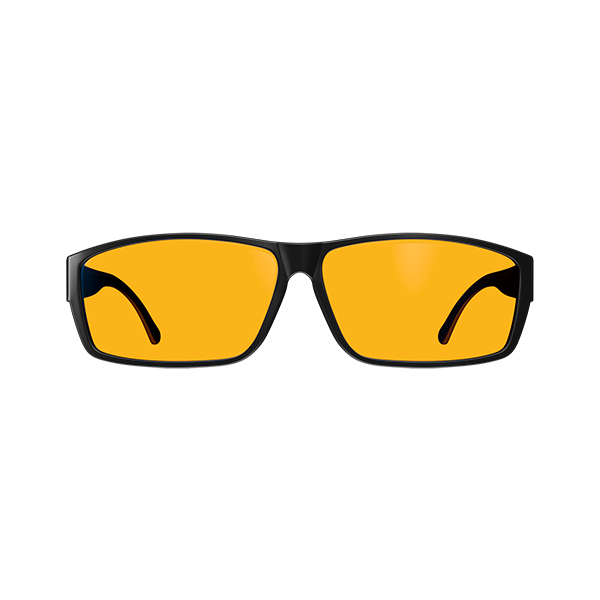Blue light
Whilst discussing the effects of man made electromagnetic fields (EMFs) on health, it’s important to consider one EMF in particular; artificial blue light. Blue light is a frequency of light emitted by electronic devices, such as TVs, iPads, smartphones, and fluorescent bulbs. It’s also found in natural sunlight. We can call blue light “junk or artificial light” when it’s man-made by electronics rather than the sun.
The concept of blocking the blue light spectrum to improve sleep and health has been around since the 1970’s. That was when the tiny brain region called the Suprachiasmatic Nucleus (SCN) was discovered. The SCN helps to control the body’s sleep cycles, wakefulness and other daily fluctuations. Glasses that have orange lenses, also known as “blue light blocking glasses” were developed to block 100% of the blue spectrum. This became the mainstay solution to address the impact of light on the SCN. But back in the 70’s, blue light was a very small problem, so it wasn’t widely adopted. However around 1992, everything changed. The era of artificial light blue began. This was when technology was developed to generate full-spectrum white LED light and the high-brightness blue LED was born. Today, most of us live under constant bright-white light, which tells our SCN and physiology it’s always “noon”, even if it’s 6 am or 6 pm. That also coincided with the beginning of computers (with bright blue screens) in more homes, more TV time, and eventually tables and smartphones. The result is that people were surrounded by this light 24 hours per day for the first time in history.
We’ve discovered that this artificial light has profound effects on our health, particularly our circadian rhythms. For billions of years, humans have evolved and lived under the cycles of the sun and moon but the introduction of artificial light has thrown everything out of sync, particularly melatonin. Melatonin, also known as N-acetyl-5-methoxy tryptamine, is actually an extremely potent anti-oxidant that goes around the body each night clearing out dead cells and repairing DNA, far more powerful than vitamin C. Anything that inhibits melatonin production causes premature aging by default. Your melapsoin sensors, which trigger your body to make melatonin, are incredibly sensitive to blue and green light so you want to make sure that your evening glasses are as dark orange or even red-ish if possible.
Why natural light is so important
Natural light was here a long time before food was. Plants still do not rely on food, they rely on the photoelectric effect for energy to recycle atoms in the air and dirt. Light sculpts life in plants and all plants form the basis of the entire food web. It is a well-known fact that photosynthesis forms the entire food web on Earth. One thousand different genes governing virtually every tissue in the body are now thought to be regulated by Vitamin D. Vitamin D can be synthesized in the skin through a photosynthetic reaction triggered by exposure to UVB radiation. Sufficient vitamin D levels are also associated with better immune health due to Vitamin D inducing cathelicidin, a polypeptide that effectively combats both bacterial and viral infections. This may explain the seasonal issues with influenza and other infective diseases.
Water scientist and biomedical engineer Gerald Pollack shares new information and ideas about simple things we can do to charge up our human cells faster than our cell phones. The report from his lab will surprise you.
How to manage the era of artificial blue light
Get as much natural sunlight as you can. This is particularly true first thing in the morning and early evening to prime your body clock. It can’t be stressed enough how important natural light is for your health.
If you’re on man-made electronics or if you work under bright white LED or fluorescent lights during the day, then choose a blue light filtering (which are often still called) “blue blocking” lens).
Keep your bedroom dark. Use blackout curtains. Don’t use an alarm clock with numbers that glow. If that isn’t an option for you, choose a clock face with red numbers that are dimmable, and put it at the lowest brightness.
Try Avoid man-made light in the 2 hours before bed.
Blue light blocking glasses
‘Ra Optics offer high-quality, attractive frame styles, combined with the Gold Standard of Blue Light Blocking Technology. Our lenses are made by the world’s top quality lens manufacturer and are infused with pigments specifically designed to absorb all harmful blue light frequencies, while providing superior optics’
- RA OPTICS 10% DISCOUNT: ENTER ‘EMFHOME’ AT CHECKOUT -
‘DefenderShield® Blue Light Blocking Glasses block harmful blue light to help reduce the negative health effects of computer and mobile device screens. Our superior quality lenses filter blue light that can cause digital eye strain, premature eye-aging, and interfere with sleep’
‘Swanwick spent nine months researching blue light and trying to produce the perfect orange lens, that actually worked. They also searched for the most stylish frames to house the blue-light blocking technology. In November, 2015 they launched their sleep company, Swanwick Sleep and its blue light blocking glasses’














